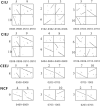An intelligent recognition method of chromosome rearrangement patterns based on information entropy
- PMID: 36385139
- PMCID: PMC9668828
- DOI: 10.1038/s41598-022-22046-x
An intelligent recognition method of chromosome rearrangement patterns based on information entropy
Abstract
Chromosome rearrangements play an important role in the speciation of plants and animals, and the recognition of chromosome rearrangement patterns is helpful to elucidate the mechanism of species differentiation at the chromosome level. However, the existing chromosome rearrangement recognition methods have some major limitations, such as low quality, barriers to parental selection, and inability to identify specific rearrangement patterns. Based on the whole genome protein sequences, we constructed the combined figure according to the slope of the collinear fragment, the number of homologous genes, the coordinates in the top left and bottom right of the collinear fragment. The standardized combination figure is compared with the four standard pattern figures, and then combined with the information entropy analysis strategy to automatically classify the chromosome images and identify the chromosome rearrangement pattern. This paper proposes an automatic karyotype analysis method EntroCR (intelligent recognition method of chromosome rearrangement based on information entropy), which integrates rearrangement pattern recognition, result recommendation and related chromosome determination, so as to infer the evolution process of ancestral chromosomes to the existing chromosomes. Validation experiments were conducted using whole-genome data of Gossypium raimondii and Gossypium arboreum, Oryza sativa and Sorghum bicolor. The conclusions were consistent with previous results. EntroCR provides a reference for researchers in species evolution and molecular marker assisted breeding as well as new methods for analyzing karyotype evolution in other species.
© 2022. The Author(s).
Conflict of interest statement
The authors declare no competing interests.
Figures





Similar articles
-
Improved reconstruction and comparative analysis of chromosome 12 to rectify Mis-assemblies in Gossypium arboreum.BMC Genomics. 2020 Jul 8;21(1):470. doi: 10.1186/s12864-020-06814-5. BMC Genomics. 2020. PMID: 32640982 Free PMC article.
-
Rapid evolutionary divergence of diploid and allotetraploid Gossypium mitochondrial genomes.BMC Genomics. 2017 Nov 13;18(1):876. doi: 10.1186/s12864-017-4282-5. BMC Genomics. 2017. PMID: 29132310 Free PMC article.
-
Development of chromosome-specific markers with high polymorphism for allotetraploid cotton based on genome-wide characterization of simple sequence repeats in diploid cottons (Gossypium arboreum L. and Gossypium raimondii Ulbrich).BMC Genomics. 2015 Feb 6;16(1):55. doi: 10.1186/s12864-015-1265-2. BMC Genomics. 2015. PMID: 25652321 Free PMC article.
-
Marsupials as models for understanding the role of chromosome rearrangements in evolution and disease.Chromosoma. 2016 Sep;125(4):633-44. doi: 10.1007/s00412-016-0603-8. Epub 2016 Jun 3. Chromosoma. 2016. PMID: 27255308 Review.
-
Chromothripsis: A New Mechanism for Rapid Karyotype Evolution.Annu Rev Genet. 2015;49:183-211. doi: 10.1146/annurev-genet-120213-092228. Epub 2015 Oct 6. Annu Rev Genet. 2015. PMID: 26442848 Review.
References
Publication types
MeSH terms
Grants and funding
- QN2020421/Science and Technology Project of Hebei Education Department
- CARS-08-G-22/China Agriculture Research System of MOF and MARA- Food Legumes
- 31901864/National Natural Science Foundation of China
- YJ201944/Scientific Research Project of Introducing Talents of Hebei Agricultural University
- C2020204111/Innovative Research Group Project of Hebei Natural Science Foundation
LinkOut - more resources
Full Text Sources

